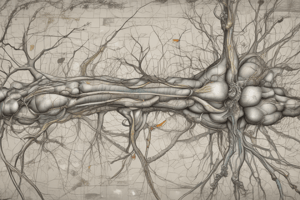Podcast
Questions and Answers
A patient presents with an inability to abduct their arm and sensory loss over the 'regimental badge area' following a traumatic shoulder dislocation. Damage to which nerve is MOST consistent with these findings?
A patient presents with an inability to abduct their arm and sensory loss over the 'regimental badge area' following a traumatic shoulder dislocation. Damage to which nerve is MOST consistent with these findings?
- Long thoracic nerve
- Suprascapular nerve
- Musculocutaneous nerve
- Axillary nerve (correct)
Following a deep laceration to the anterior upper arm, a patient exhibits weakness in elbow flexion and supination, along with sensory loss along the lateral forearm. Which nerve is MOST likely compromised?
Following a deep laceration to the anterior upper arm, a patient exhibits weakness in elbow flexion and supination, along with sensory loss along the lateral forearm. Which nerve is MOST likely compromised?
- Axillary nerve
- Musculocutaneous nerve (correct)
- Median nerve
- Radial nerve
A patient presents with wrist drop, but maintains full strength in elbow extension. Where is the MOST probable location of the radial nerve injury?
A patient presents with wrist drop, but maintains full strength in elbow extension. Where is the MOST probable location of the radial nerve injury?
- Mid-humerus
- Spiral groove of the humerus
- Axilla
- Supinator canal (correct)
A surgeon inadvertently damages a nerve during a carpal tunnel release. Post-operatively, the patient exhibits thenar atrophy but no sensory deficits. Which branch of the median nerve was MOST likely injured?
A surgeon inadvertently damages a nerve during a carpal tunnel release. Post-operatively, the patient exhibits thenar atrophy but no sensory deficits. Which branch of the median nerve was MOST likely injured?
A patient demonstrates an inability to make a fist with the 4th and 5th digits, experiences weakness in finger abduction/adduction, and has sensory loss on the medial side of the hand. Which nerve is MOST likely affected?
A patient demonstrates an inability to make a fist with the 4th and 5th digits, experiences weakness in finger abduction/adduction, and has sensory loss on the medial side of the hand. Which nerve is MOST likely affected?
A patient presents with foot drop, exhibiting weakness in ankle dorsiflexion and eversion. Sensory loss is noted on the anterior and lateral aspects of the leg and dorsum of the foot. Injury to which nerve is MOST likely?
A patient presents with foot drop, exhibiting weakness in ankle dorsiflexion and eversion. Sensory loss is noted on the anterior and lateral aspects of the leg and dorsum of the foot. Injury to which nerve is MOST likely?
After a motorcycle accident resulting in a fractured femur, a patient cannot extend their knee and has diminished sensation over the anterior thigh and medial leg. Which nerve is MOST likely injured?
After a motorcycle accident resulting in a fractured femur, a patient cannot extend their knee and has diminished sensation over the anterior thigh and medial leg. Which nerve is MOST likely injured?
A patient with a history of pelvic surgery presents with weakness in hip adduction. Sensory examination reveals decreased sensation along the medial aspect of the thigh. Which nerve is MOST likely compromised?
A patient with a history of pelvic surgery presents with weakness in hip adduction. Sensory examination reveals decreased sensation along the medial aspect of the thigh. Which nerve is MOST likely compromised?
A patient cannot plantarflex the foot, has difficulty with toe flexion, and experiences sensory loss on the plantar surface of the foot. Damage to which nerve is MOST likely?
A patient cannot plantarflex the foot, has difficulty with toe flexion, and experiences sensory loss on the plantar surface of the foot. Damage to which nerve is MOST likely?
A patient presents with numbness and tingling in the sole of their foot, that worsens with prolonged standing and walking. Which of the following examination techniques would be MOST appropriate to confirm this diagnosis?
A patient presents with numbness and tingling in the sole of their foot, that worsens with prolonged standing and walking. Which of the following examination techniques would be MOST appropriate to confirm this diagnosis?
A construction worker falls and sustains a Colles fracture. Several weeks later he is experiencing numbness and tingling in his thumb, index and middle fingers. Nighttime symptoms are particularly bothersome. Which of the following special tests would MOST likely be positive?
A construction worker falls and sustains a Colles fracture. Several weeks later he is experiencing numbness and tingling in his thumb, index and middle fingers. Nighttime symptoms are particularly bothersome. Which of the following special tests would MOST likely be positive?
A patient with weakness after nerve damage has a motor strength that is graded 2/5. According to the standard motor scale, what does this indicate?
A patient with weakness after nerve damage has a motor strength that is graded 2/5. According to the standard motor scale, what does this indicate?
Following a complete transection and surgical repair of the ulnar nerve at the wrist, what is the approximate expected rate of nerve regeneration?
Following a complete transection and surgical repair of the ulnar nerve at the wrist, what is the approximate expected rate of nerve regeneration?
A patient has weakness abducting their right hip. The examiner notes the patient has a positive Trendelenburg sign on the right. Which nerve is MOST likely affected?
A patient has weakness abducting their right hip. The examiner notes the patient has a positive Trendelenburg sign on the right. Which nerve is MOST likely affected?
A patient reports numbness and tingling in the fourth and fifth digits of their right hand after a biking accident. Examination reveals decreased sensation over the palmar surface of these digits, but normal sensation on the dorsal surface. Grip strength is also diminished. Which anatomical structure is MOST likely the site of nerve compression?
A patient reports numbness and tingling in the fourth and fifth digits of their right hand after a biking accident. Examination reveals decreased sensation over the palmar surface of these digits, but normal sensation on the dorsal surface. Grip strength is also diminished. Which anatomical structure is MOST likely the site of nerve compression?
A 38-year-old female presents with weakness and wasting of the thenar muscles. She denies any sensory loss in her hand. Which of the following is the MOST likely cause of her presentation?
A 38-year-old female presents with weakness and wasting of the thenar muscles. She denies any sensory loss in her hand. Which of the following is the MOST likely cause of her presentation?
A patient is diagnosed with carpal tunnel syndrome. Which of the following muscles would be MOST affected?
A patient is diagnosed with carpal tunnel syndrome. Which of the following muscles would be MOST affected?
A patient presents with an altered gait. They have excessive hip flexion to compensate for foot drop. They also have numbness and tingling on the dorsum of the foot. Where is the MOST likely site of nerve compression?
A patient presents with an altered gait. They have excessive hip flexion to compensate for foot drop. They also have numbness and tingling on the dorsum of the foot. Where is the MOST likely site of nerve compression?
During a complicated total hip arthroplasty, the surgeon places several retractors that place excessive pressure on the sciatic nerve. What muscles will MOST likely be affected?
During a complicated total hip arthroplasty, the surgeon places several retractors that place excessive pressure on the sciatic nerve. What muscles will MOST likely be affected?
Flashcards
Axillary Nerve Injury
Axillary Nerve Injury
Results from shoulder dislocation/humerus fracture, causing weakness in arm abduction/external rotation and sensory loss over the lateral shoulder.
Musculocutaneous Nerve Injury
Musculocutaneous Nerve Injury
Often injured by trauma, results in weakness of elbow flexion/supination and sensory loss along the lateral forearm.
Radial Nerve Injury
Radial Nerve Injury
High injury causes paralysis of extensors, leading to wrist drop. Sensory loss on posterior arm/hand.
Median Nerve Injury
Median Nerve Injury
Signup and view all the flashcards
Ulnar Nerve Injury
Ulnar Nerve Injury
Signup and view all the flashcards
Sciatic Nerve Injury
Sciatic Nerve Injury
Signup and view all the flashcards
Femoral Nerve Injury
Femoral Nerve Injury
Signup and view all the flashcards
Obturator Nerve Injury
Obturator Nerve Injury
Signup and view all the flashcards
Common Peroneal Nerve Injury
Common Peroneal Nerve Injury
Signup and view all the flashcards
Tibial Nerve Injury
Tibial Nerve Injury
Signup and view all the flashcards
Carpal Tunnel Syndrome
Carpal Tunnel Syndrome
Signup and view all the flashcards
Cubital Tunnel Syndrome
Cubital Tunnel Syndrome
Signup and view all the flashcards
Peroneal Nerve Entrapment
Peroneal Nerve Entrapment
Signup and view all the flashcards
Tarsal Tunnel Syndrome
Tarsal Tunnel Syndrome
Signup and view all the flashcards
Phalen's Test
Phalen's Test
Signup and view all the flashcards
Tinel's Sign
Tinel's Sign
Signup and view all the flashcards
Trendelenburg Test
Trendelenburg Test
Signup and view all the flashcards
Study Notes
- Nerve lesions can occur due to trauma, compression, ischemia, or inflammation
Upper Limb Nerve Lesions
- Axillary Nerve:
- Injury typically results from shoulder dislocation or fracture of the surgical neck of the humerus
- Leads to paralysis of the deltoid and teres minor muscles, causing weakness in abduction and external rotation of the arm
- Sensory loss may occur over the lateral aspect of the shoulder (regimental badge area)
- Musculocutaneous Nerve:
- Often injured due to penetrating trauma or forceful traction injuries
- Results in weakness of elbow flexion (biceps brachii, brachialis) and supination (biceps brachii)
- Sensory loss occurs along the lateral aspect of the forearm
- Radial Nerve:
- Can be damaged in the axilla (e.g., from crutches – "crutch palsy"), mid-humerus fractures, or compression in the forearm (e.g., supinator entrapment)
- High radial nerve injury (axilla) causes paralysis of the triceps brachii, brachioradialis, wrist extensors, and finger extensors, leading to wrist drop
- Sensory loss occurs over the posterior aspect of the arm and forearm, as well as the dorsal aspect of the hand (excluding the digits)
- If the radial nerve is compressed more distally (e.g., in the supinator muscle), wrist drop may occur, with sparing of triceps function
- Median Nerve:
- Can be injured at the elbow (e.g., supracondylar fracture) or at the wrist (carpal tunnel syndrome)
- High median nerve injury (elbow) causes weakness of forearm pronation, wrist flexion, and finger flexion of the lateral digits (digits 1-3)
- Results in an inability to oppose the thumb (ape hand deformity) and sensory loss over the palmar aspect of the lateral hand and digits 1-3
- Carpal tunnel syndrome: Compression of the median nerve in the carpal tunnel leads to sensory disturbances (numbness, tingling) in the median nerve distribution and weakness/atrophy of the thenar muscles; Phalen's test and Tinel's sign can help diagnose this
- Ulnar Nerve:
- Vulnerable to injury at the elbow (cubital tunnel syndrome) or wrist (Guyon's canal)
- High ulnar nerve injury (elbow) causes weakness of wrist flexion and adduction, finger flexion of digits 4-5, and intrinsic hand muscle weakness (interossei, adductor pollicis, hypothenar muscles)
- Results in claw hand deformity (digits 4-5), inability to abduct or adduct the fingers, and sensory loss over the medial aspect of the hand and digits 4-5
- Injury at Guyon's canal will spare the dorsal cutaneous branch; therefore, it will present with motor deficits and sensory loss over the palmar side of digits 4-5 only
Lower Limb Nerve Lesions
- Sciatic Nerve:
- Can be injured by hip dislocation, intramuscular injections, or compression
- Results in weakness of knee flexion (hamstrings) and all movements below the knee (foot and ankle)
- Sensory loss occurs over the posterior aspect of the thigh, lateral aspect of the leg, and the entire foot (except for the saphenous nerve distribution)
- Femoral Nerve:
- Can be damaged by pelvic fractures, hematomas, or compression
- Causes weakness of knee extension (quadriceps femoris) and hip flexion (iliopsoas, sartorius)
- Sensory loss occurs over the anterior and medial aspects of the thigh and medial aspect of the leg (saphenous nerve)
- Obturator Nerve:
- Often injured during pelvic surgery or due to compression
- Leads to weakness of hip adduction (adductor muscles)
- Sensory loss may occur over the medial aspect of the thigh
- Common Peroneal (Fibular) Nerve:
- Vulnerable to injury at the fibular neck (e.g., from leg casts, crossing legs)
- Causes weakness of ankle dorsiflexion (tibialis anterior), foot eversion (peroneal muscles), and toe extension
- Leads to foot drop and a steppage gait
- Sensory loss occurs over the anterior and lateral aspects of the leg and the dorsum of the foot
- Tibial Nerve:
- Can be injured in the popliteal fossa or at the ankle (tarsal tunnel syndrome)
- Causes weakness of ankle plantarflexion (gastrocnemius, soleus), foot inversion (tibialis posterior), and toe flexion
- Results in an inability to stand on tiptoes
- Sensory loss occurs over the plantar aspect of the foot
- Tarsal tunnel syndrome: Compression of the tibial nerve in the tarsal tunnel leads to sensory disturbances (numbness, tingling) in the tibial nerve distribution
Examination Techniques
- Motor Testing:
- Assess muscle strength using the standard 0-5 scale
- Look for specific movements affected to determine nerve involvement
- Sensory Testing:
- Test light touch, pain, temperature, and vibration sensation
- Map out areas of sensory loss to determine the distribution of nerve damage
- Reflex Testing:
- Assess deep tendon reflexes (e.g., biceps, triceps, brachioradialis, knee, ankle)
- Changes in reflexes (diminished or absent) can indicate nerve or muscle dysfunction
- Specific Tests:
- Phalen's Test: For carpal tunnel syndrome, hold the wrists in forced flexion
- Tinel's Sign: Tap over a nerve to elicit tingling sensations
- Trendelenburg Test: To assess hip abductor weakness (superior gluteal nerve)
Nerve Regeneration
- Peripheral nerves can regenerate, but the process is slow (approximately 1 mm per day)
- Recovery depends on the extent and location of the injury
- Complete transection of a nerve may require surgical repair
Important Considerations for Diagnosis
- Mechanism of Injury: Understand how the injury occurred
- Pattern of Weakness: Identify specific muscle groups affected
- Sensory Deficits: Map the distribution of sensory loss
- Associated Symptoms: Consider pain, paresthesia, and autonomic changes
Clinical Scenarios & Questions
- A patient presents with weakness in shoulder abduction and sensory loss over the lateral shoulder after a shoulder dislocation; the axillary nerve is most likely injured
- A patient reports difficulty flexing their elbow and supination of their forearm; they also have sensory loss along the lateral forearm; the musculocutaneous nerve is most likely injured
- A patient presents with wrist drop after a mid-shaft humerus fracture; the radial nerve is most likely injured
- A patient presents with numbness and tingling in their thumb, index finger, and middle finger, as well as weakness of thumb abduction; they report symptoms worsen at night; the median nerve is likely affected, and they likely have carpal tunnel syndrome
- A patient has clawing of the 4th and 5th digits and weakness in finger adduction/abduction; they also have sensory loss over the medial aspect of the hand; the ulnar nerve is most likely injured
- A patient is unable to extend their knee and has sensory loss over the anterior thigh; the femoral nerve is most likely injured
Common Nerve Entrapment Syndromes
- Carpal Tunnel Syndrome: Median nerve compression at the wrist
- Cubital Tunnel Syndrome: Ulnar nerve compression at the elbow
- Peroneal Nerve Entrapment: Common peroneal nerve compression at the fibular neck
- Tarsal Tunnel Syndrome: Tibial nerve compression at the ankle
- Nerve injuries lead to specific motor and sensory deficits, understanding the anatomy will help ascertain which nerve is injured
Studying That Suits You
Use AI to generate personalized quizzes and flashcards to suit your learning preferences.




